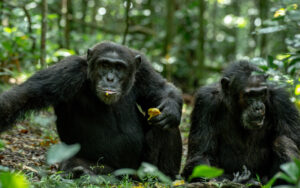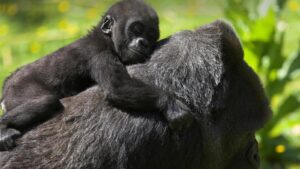A Sanctuary for Mountain Gorillas and Biodiversity.
Located in southwestern Uganda, Bwindi Impenetrable National Park is a haven for mountain gorillas, with over 400 individuals, accounting for half of the world’s population. This ancient rainforest, dating back 25,000 years, spans 321 square kilometers and is home to diverse flora and fauna.
Geography and Climate
Bwindi Impenetrable National Park is situated on the edge of the Rift Valley, featuring steep ridges and deep valleys. The park’s terrain creates a watershed for five major rivers flowing into Lake Edward. With a tropical climate, Bwindi experiences annual mean temperatures ranging from 7-15°C to 20-27°C and annual rainfall of 1,400-1,900 millimeters.
Attractions and Activities
- Mountain Gorilla Trekking: Experience the thrill of encountering habituated mountain gorilla families in their natural habitat. Four major tracking regions are available: Rushaja, Buhoma, Ruhija, and Nkuringo.
- Chimpanzee Trekking: Bwindi is one of the few places where chimpanzees and gorillas coexist. With 350 recorded chimpanzees, this activity offers a unique experience.
- Nature Walks and Trails: Explore the forest’s diverse ecosystem, spotting over 350 bird species, 120 mammals, and 220 butterfly species.
- Community Tours: Engage with the local Bakiga and Batwa pygmy communities, learning about their traditional cultures and dances.
Getting There:
Bwindi Impenetrable National Park is accessible by road or air transport. Visitors can fly into Kisoro or Kabale airstrips or drive from Kampala via Mbarara-Kabale-Rukungiri Road (approximately 8-9 hours).
Access and Accommodation
Various options are available, ranging from budget-friendly to luxury lodges, including Sanctuary Gorilla Forest Camp, Mahogany Springs Camp, and Buhoma Lodge.
Conservation Efforts
Bwindi Impenetrable National Park is a UNESCO World Heritage Site, recognized for its ecological importance and biodiversity. The park’s conservation efforts focus on protecting the mountain gorilla population and preserving the forest’s natural habitat.
Key Facts
- Mountain Gorilla Population: Over 400 individuals, accounting for half of the world’s population
- Biodiversity: 163 tree species, 104 ferns, 120 mammals, 350 birds, and 27 frogs
- Habituation Process: Mountain gorillas have been habituated for trekking and research purposes since 1993
- Unique Feature: Bwindi is one of the few places where chimpanzees and gorillas coexist.



